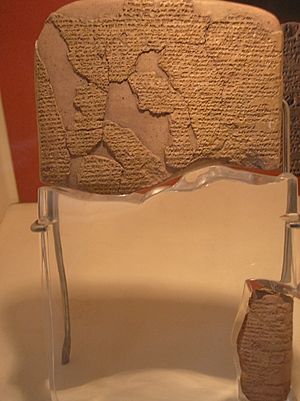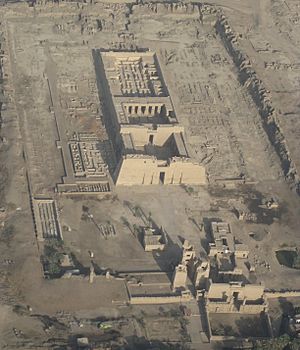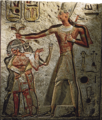Ramesses II facts for kids
Quick facts for kids Ramesses II |
|
|---|---|
| "Ramesses the Great" | |
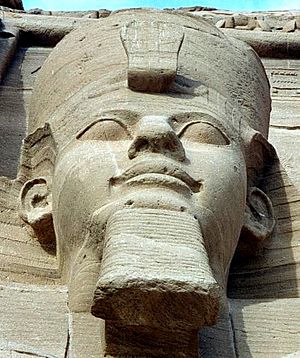
Bust of one of the four external seated statues
of Ramesses II at Abu Simbel |
|
| Pharaoh | |
| Reign | 1279–1213 BC (19th Dynasty) |
| Predecessor | Seti I |
| Successor | Merneptah |
| Consort | Nefertari, Isetnofret, Maathorneferure, Meritamen, Bintanath, Nebettawy, Henutmire |
| Children | Amun-her-khepsef, Ramesses, Pareherwenemef, Khaemwaset, Merneptah, Meryatum, Bintanath, Meritamen, Nebettawy, Henuttawy (List of children of Ramesses II) |
| Father | Seti I |
| Mother | Tuya |
| Born | c. 1303 BC |
| Died | 1213 BC (aged c. 90) |
| Burial | KV7 |
| Monuments | Abu Simbel, Abydos, Ramesseum, Luxor, Karnak |
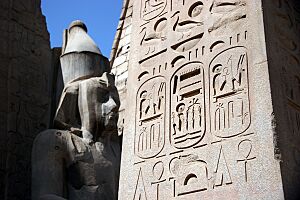
Ramesses II was one of the most famous and powerful Pharaohs of Ancient Egypt. People often called him "Ramesses the Great". He was the third pharaoh of the Nineteenth Dynasty. Later Egyptians looked up to him as a "Great Ancestor".
When Ramesses was 14 years old, his father, Seti I, chose him to be the next ruler. Ramesses II ruled Egypt for a very long time, from 1279 BC to 1213 BC. He likely lived to be about 90 or 91 years old. After he died, he was buried in a tomb in the Valley of the Kings. Later, his body was moved to a secret hiding place. It was found in 1881 and is now on display at the Cairo Museum.
Ramesses II led many trips to the north, into lands near the Mediterranean Sea. These areas are now countries like Israel, Lebanon, and Syria. He also traveled south into Nubia. Early in his rule, he focused on building new cities, temples, and huge monuments. He made the city of Pi-Ramesses in the Nile Delta his new capital. This city also served as his main base for military trips into Syria.
Contents
Early Life and Becoming Pharaoh
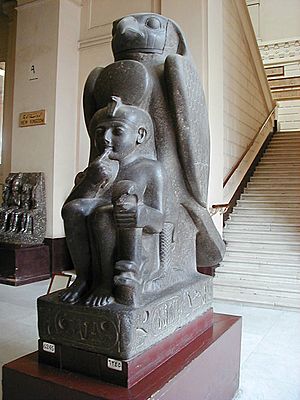
Ramesses II was not born into a royal family directly. His grandfather, Ramesses I, was a military officer who became pharaoh. Ramesses II was about eleven years old when his father, Seti I, became king.
Seti I then named his son, Ramesses II, as the prince regent. This meant Ramesses II was chosen to rule after his father. At this time, Ramesses II was about fourteen years old. Most experts believe Ramesses officially became pharaoh on May 31, 1279 BC.
Important Battles and Peace Treaties
When he was young, Ramesses II went on many military trips. He wanted to get back land that Egypt had lost to the Nubians and Hittites. He also worked to keep Egypt's borders safe. He stopped rebellions in Nubia and fought in Libya.
Stopping Sea Pirates
In his second year as pharaoh, Ramesses defeated the Sherden sea pirates. These pirates were attacking ships carrying goods along Egypt's Mediterranean Sea coast. Ramesses placed soldiers and ships at important points along the coast. He let the pirates attack, then surprised them in a sea battle. He captured all of them in one swift action.
A special stone carving, called a stele, says the pirates came "in their war-ships from the midst of the sea." It also says "none were able to stand before them." After this, some Sherden warriors joined the pharaoh's personal guards. They wore their unique horned helmets and carried round shields.
Making Peace with the Hittites
A Hittite prince named Mursili III ran away to Egypt after trying to take his uncle's throne. His uncle, Hattusili III, demanded that Ramesses send Mursili back to Hatti. This caused a big problem between Egypt and Hatti. Ramesses said he did not know where Mursili was. The two powerful empires almost went to war.
Finally, in the twenty-first year of his rule (1258 BC), Ramesses decided to make a deal with Hattusili III. This agreement helped end the conflict. The peace treaty was written in two languages. One version was in Egyptian hieroglyphs, and the other was in Akkadian using cuneiform writing. Both versions still exist today.
These two versions are worded a bit differently. The Hittite version says the Egyptians asked for peace first. The Egyptian version says the opposite. The treaty was given to the Egyptians on a silver plaque. A copy of this treaty was carved into the walls of the Temple of Karnak. This is the earliest known peace treaty in world history.
Amazing Building Projects
In his third year as pharaoh, Ramesses started huge building projects. These were the most ambitious since the pyramids, built almost 1,500 years earlier. He had many people working to change the look of Egypt. Ramesses built many structures from the Delta all the way to Nubia. He covered the land with buildings like no other ruler before him.
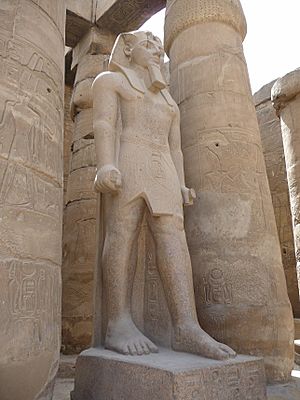
Ramesses also updated or took over existing buildings. He improved how stone was used in building. He also used art to show his power and victories.
- In Thebes, old temples were changed to honor Ramesses. This showed his divine nature and power.
- Earlier pharaohs had shallow carvings that were easy to change. Ramesses made sure his carvings were deep in the stone. This made them harder to change later. It also made them stand out more in the Egyptian sun. This showed his connection to the sun god, Ra.
- Ramesses used art to show his victories over foreign enemies. These scenes are on many temple walls.
- His royal names, called cartouches, are seen everywhere. Even on buildings he did not build himself.
- He built a new capital city in the Delta called Pi-Ramesses. It had been a summer palace for his father.
- Ramesses II also made gold mining bigger in an area called Akuyati.
Ramesses started many new building projects. Two of his most famous works, besides Pi-Ramesses, are the temple complex of Abu Simbel and the Ramesseum. The Ramesseum was a mortuary temple, built for his burial, in western Thebes.
Pi-Ramesses: A New Capital
Ramesses II moved Egypt's capital from Thebes to a new place in the eastern Delta. We are not sure why he moved it. Maybe he wanted to be closer to his lands in Canaan and Syria. The new city was called Pi-Ramesses. Its full name meant "Domain of Ramesses, Great in Victory." It had huge temples and his very large royal palace, even with its own zoo! Today, only the giant feet of a statue of Ramesses remain above ground. The rest of the city is buried.
The Ramesseum: A Grand Mortuary Temple
The temple complex built by Ramesses II is known as the Ramesseum. It is located between Qurna and the desert. The temple faced northwest and southeast and had two large courtyards. A huge gateway, called a pylon, stood before the first court. The royal palace was on the left. A giant statue of the king stood at the back. Only parts of the base and body of this statue remain. It was 17 meters (56 feet) tall and weighed over 1,000 tons.
Scenes on the pylon show the pharaoh and his army winning against the Hittites near Kadesh. The second court also shows scenes of war and the Hittites running away from Kadesh. On the upper walls, there are pictures of feasts and honors for Min, the god of fertility.
In the great hypostyle hall, 39 of the original 48 columns still stand. They are decorated with scenes of the king with different gods. Part of the ceiling, with gold stars on a blue background, is also still there. Pictures of Ramesses's many children are on the remaining walls. The temple also had large storage rooms made of mud bricks. Traces of a school for scribes were found among the ruins.
Abu Simbel: Temples Carved in Stone
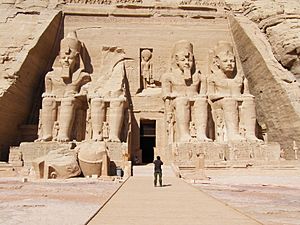
In 1255 BC, Ramesses and his main queen, Nefertari, traveled to Nubia. They went to open a new temple, the great Abu Simbel. This temple was built to show Ramesses's power and importance. He wanted to be remembered as Egypt's greatest pharaoh and even as a god.
The Great Temple of Ramesses II at Abu Simbel was found in 1813. A huge pile of sand almost completely covered its front and giant statues. This blocked the entrance for four more years. An explorer named Giovanni Battista Belzoni finally entered the temple on August 4, 1817.
Other Nubian Temples
Ramesses built other monuments to himself in Nubia. His early military trips are shown on the walls of the Temple of Beit el-Wali. This temple has been moved to a new location. Other temples dedicated to Ramesses include Derr and Gerf Hussein. These have also been moved. The foundation of the temple of Amun at Jebel Barkal was likely started by an earlier pharaoh, but Ramesses II helped shape it.
Discovering Ramesses II's Mummy

Ramesses II was first buried in KV7, a tomb in the Valley of the Kings. But because people were stealing from the tombs, priests later moved his body. They re-wrapped it and placed it in the tomb of Queen Ahmose Inhapy. Seventy-two hours later, it was moved again to the tomb of the high priest Pinedjem II. All these moves are written in hieroglyphics on the linen covering his coffin.
His mummy was finally found in 1881 in TT320. It was inside a simple wooden coffin. Today, Ramesses II's mummy is in Cairo's National Museum of Egyptian Civilization.
Interesting Facts About Ramesses II
- Ramesses ruled Egypt for a very long time: 66 years and 2 months.
- During his rule, the Egyptian army may have had about 100,000 soldiers.
- The peace treaty Ramesses signed with Hattusili III is the oldest known peace treaty in the world.
- Ramesses II suffered from arthritis. This made him walk with a hunched back for the last years of his life.
- He also had serious dental problems.
- He died when he was around 90 years old. He outlived many of his wives and children.
- Nine more pharaohs after him took the name Ramesses to honor him.
Images for kids
-
A relief of Ramses II from Memphis showing him capturing enemies: a Nubian, a Libyan and a Syrian, circa 1250 BC. Cairo Museum.
-
Color reproduction of the relief depicting Ramesses II storming the Hittite fortress of Dapur
-
West Asiatic prisoners of Ramses II at Abu Simbel.
-
The Younger Memnon: part of colossal statue of Ramesses from Ramesseum, now in British Museum
-
Scattered remains displayed in front of Osirid statues
See also
 In Spanish: Ramsés II para niños
In Spanish: Ramsés II para niños



